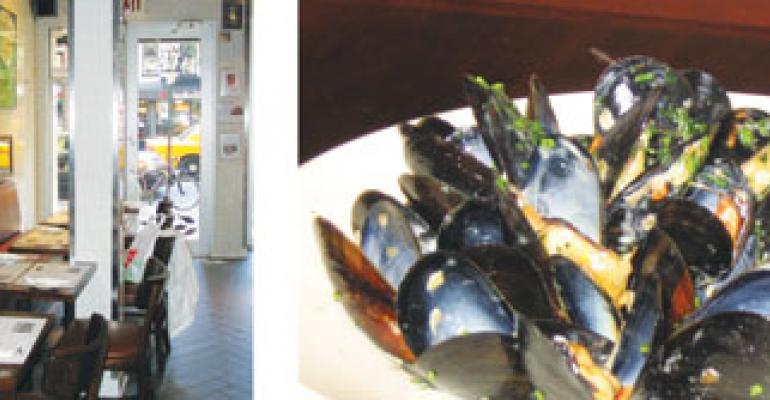At Wild Edibles Oyster Bar & Restaurant guests are served seafood in three different ways: through delivery, through sit-down service at the bar or through takeout from the retail market. Ninety percent of what is ordered from the bar or restaurant menu is taken directly from the retail market, or “fish stand,” where seafood is kept on ice behind a glass window.
Owner Richard Martin became inspired to deliver “hand-picked specialties from the seas” shortly after his brother-in-law returned from a trip to Portland, Maine, that uncovered a variety of foods not frequently available in New York markets, including wild raspberries, wild mushrooms and sea urchins.
Eager to deliver such items to New York’s top chefs and seafood purveyors, Martin opened Wild Edibles in 1992 using his car for deliveries, his home for storage and just $1,000 to start off with. Before long, he had five seafood markets. The location in the Murray Hill area of Manhattan is the only one to include a restaurant, which was added last year.
“I wanted something casual, inexpensive and good quality,” Martin says.
Customers can enjoy more than 30 varieties of seafood for less than $27 in a casual atmosphere.
“The concept is pick your own fish, have it cooked the way you want it cooked and just sit down and have some nice local wine or oysters to go with it,” Martin says.
“It’s the overriding concept of pulling [fish] off the stand and cooking it fresh,” says executive chef Paul Jambor.
Customers can watch the process of their food being prepared and they also can learn about it.
That’s because the restaurant partners with the Blue Ocean Institute and posts laminated signs with each fish’s name and origin, health risks for consumption, and the environmental implications of the way it’s caught. Manager Michael Poli says the goal is to encourage customers to make more informed choices about their seafood selection as well as to raise awareness that there needs to be limitations on what’s being sold.
“It makes it educational for everybody,” Martin says.
Although he recognizes that the customer’s main goal is to eat, he figures that “if they can learn at the same time in a fun way, then it’s a win-win situation.”
The restaurant also provides four different placemats with historical information researched by employees on the seafood they serve.
Wild Edibles also is environmentally conscious in the way it sources fish and selects wines.
“We try to look at other fish that is as sustainable as possible,” Martin says.
AT A GLANCE Cuisine: American seafood bistroLocation: 535 Third AvenueWebsite:
When buying from seafood purveyors, he looks to the companies that seem the most environmentally friendly in their farming and fishing methods.
Additionally, more than half of Wild Edibles’ wines are biodynamic or organic.
Poli says the guest demographic is a mix of the younger crowd that just moved into the Murray Hill neighborhood, older businessmen and “the seafood elite of Manhattan.” Customers can choose from a lunch and dinner menu, with entrée prices ranging from $18-$23 and appetizers from $7-$12.
The restaurant’s signature items are its three tartares, the sautéed skate, and the fish and chips. To prepare the starter dish of three tartares, Jambor cuts, mixes and then dresses each tartare separately—the tuna getting a wasabi vinaigrette dressing, the smoked salmon an avocado-and-Japanese-mayonnaise-based dressing and the bass a classic ceviche dressing. He serves the tartares in three rings on a plate with diced beets and plantain chips on top.
To make the sautéed skate, served with Dijon mustard sauce and fingerling potatoes, Jambor sautées the skate and then sautées the fingerling potatoes and haricots verts with wine, shallots, butter and fines herbes. Crispy shallots top off the dish.
The restaurant’s fastest-selling dish is classic mussels marinière.
“The seasonal availability of various fish is really the driving force behind menu changes,” Jambor says. “It’s so central to the theme of our restaurant that the fish be great.”
Martin says the fact that the restaurant doesn’t smell like fish is a sign of freshness.
“If the place smells fishy, you’re in a bad fish shop,” he says. “You’re supposed to smell the sea.”
| Starters |
| OYSTER TEMPURA: Seaweed salad: $12 |
| CRISPY ASPARAGUS: Miso sauce: $9 |
| LUMP CRAB CAKE: Rémoulade sauce: $10 |
| BAKED STUFFED CLAMS: Chorizo, roasted peppers: $10 |
| THREE TARTARES: Tuna, smoked salmon, bass: $13 |
| CRISPY GOAT CHEESE SALAD: Mesclun greens, pickled beets: $7 |
| STEAMED MUSSELS: Classic marinière: $11 |
| CRISPY FRIED CALAMARI: Roasted poblano dipping sauce: $10 |
| Entrées |
| PAN-SEARED SABLE: Miso-honey sauce, asparagus tempura: $22 |
| SAUTÉED SKATE: Dijon mustard sauce, fingerling potatoes: $18 |
| LOBSTER RAVIOLI: Oven-dried tomato, vodka cream sauce: $19 |
| WILD SALMON: Green lentils, sun-dried tomato, sautéed arugula: $23 |
| PAN SEARED HALIBUT: clams, braised leeks: $22 |
| SOFT-SHELL CRABS: Mesclun salad, scampi sauce: $22 |
| SEARED SCALLOPS: Smoked onions, spinach, warm bacon vinaigrette: $21 |
| Bar Menu |
| Each served with fries. |
| FISH and CHIPS: Cole slaw: $14 |
| SHRIMP and CHIPS: Cole slaw: $18 |
| OYSTERS and CHIPS: Cole slaw: $18 |
| LOBSTER ROLL: $23 |
| SEARED SESAME TUNA WRAP: Chipotle mayo: $14 |
| TUNA or SALMON BURGER: Lettuce and tomato: $14 |
As for future plans for Wild Edibles, Martin aims to continue improving the sustainability of his seafood.
“I never thought 15 years ago about sustainability, but now, as I got older, I’m looking at this [issue] and thinking that this is where the future is,” he says. “I want to bring my company in that direction.”
He continues to hold quarterly “sustainable parties” involving an information session at the restaurant with seafood purveyors, Blue Ocean Institute representatives and Wild Edibles customers. Among other future projects, he hopes to work with Jambor on translating the Blue Ocean Institute signage onto the restaurant’s printed menu.

